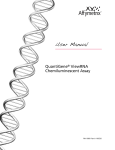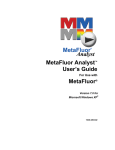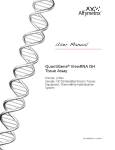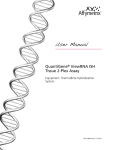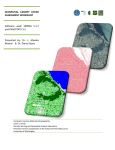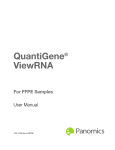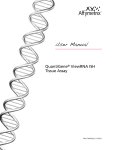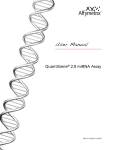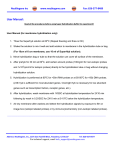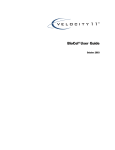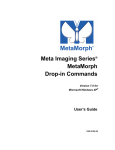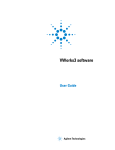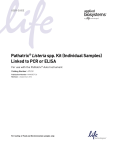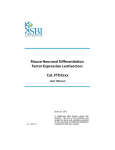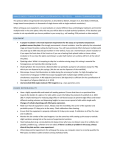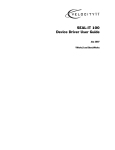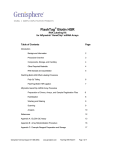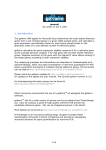Download QuantiGene® ViewRNA Plate-Based Assay
Transcript
QuantiGene ViewRNA Plate-Based Assay ® (for adherent cells) User Manual P/N 16820 Rev B 091009 DRAFT October 9, 2009 9:34 am QGViewRNAPlateTtile.fm Panomics, Inc. QuantiGene ViewRNA Plate-Based User Manual Copyright © Copyright 2009, Panomics, Inc. All rights reserved. Trademarks QuantiGene is a registered trademark exclusively licensed to Panomics, Inc. All other trademarks belong to their respective owners. Citing QuantiGene ViewRNA in Publications When describing a procedure for publication using this product, please refer to it as the QuantiGene ViewRNA assay. If a paper cites a QuantiGene ViewRNA product and is published in a research journal, the lead author(s) may receive a travel stipend for use at a technology conference or tradeshow by sending a copy of the paper to our technical support group at [email protected] or via fax at (510) 818-2610. Disclaimer Panomics, Inc. reserves the right to change its products and services at any time to incorporate technological developments. This manual is subject to change without notice. Although this manual has been prepared with every precaution to ensure accuracy, Panomics, Inc. assumes no liability for any errors or omissions, nor for any damages resulting from the application or use of this information. Contacting Panomics U.S Corporate Headquarters Panomics, Inc. 6519 Dumbarton Circle Fremont, CA 94555 Toll Free: 877 PANOMICS (1.877.726.6642) Direct: 1.510.818.2600 Fax: 1.510.818.2610 Email: [email protected] Email: [email protected] Email: [email protected] European Headquarters Panomics Srl Via Sardegna 1 20060 Vignate-Milano (Italy) Tel: +39.02.95.360.250 Fax: +39.02.360.992 Email: [email protected] Email: [email protected] Email: [email protected] Asia Pacific Headquarters Panomics, Inc. 16F Gemdale Plaza Tower A, No. 91 Jiango Road, Beijing 100022 P.R. China Tel: +86.10.59208157 Fax: +86.10.59208111 Email: [email protected] Email: [email protected] Email: [email protected] DRAFT October 9, 2009 9:34 am QGViewRNAPlateTtile.fm Contents Section I: Introduction . . . . . . . . . . . . . . . . . . . . . . . . . . . . . . . . . . . . . . . . . . . . . . . . . . 1 About This Manual . . . . . . . . . . . . . . . . . . . . . . . . . . . . . . . . . . . . . . . . . . . . . . . . 1 QuantiGene ViewRNA Assay Basics . . . . . . . . . . . . . . . . . . . . . . . . . . . . . . . . . . 1 How It Works . . . . . . . . . . . . . . . . . . . . . . . . . . . . . . . . . . . . . . . . . . . . . . . . . . . . 1 Section II: Required Materials . . . . . . . . . . . . . . . . . . . . . . . . . . . . . . . . . . . . . . . . . . . . 2 QuantiGene ViewRNA Reagent System . . . . . . . . . . . . . . . . . . . . . . . . . . . . . . . 2 QuantiGene ViewRNA Plate-based Assay Kit Components . . . . . . . . . . . . . . . . 2 QuantiGene ViewRNA Plate-Based Signal Amplification Kits . . . . . . . . . . . . . . . 2 QuantiGene ViewRNA Probe Sets. . . . . . . . . . . . . . . . . . . . . . . . . . . . . . . . . . . . 3 Required Materials Not Provided . . . . . . . . . . . . . . . . . . . . . . . . . . . . . . . . . . . . . 3 Section III: Recommendations for Experimental Design and Assay Optimization . . . . . 6 Overview . . . . . . . . . . . . . . . . . . . . . . . . . . . . . . . . . . . . . . . . . . . . . . . . . . . . . . . 6 Selecting the Appropriate Plate type . . . . . . . . . . . . . . . . . . . . . . . . . . . . . . . . . . 6 Replicates . . . . . . . . . . . . . . . . . . . . . . . . . . . . . . . . . . . . . . . . . . . . . . . . . . . . . . 6 Assessing Background for New Projects . . . . . . . . . . . . . . . . . . . . . . . . . . . . . . . 6 Using New Probe Sets . . . . . . . . . . . . . . . . . . . . . . . . . . . . . . . . . . . . . . . . . . . . . 7 Optimizing Assay Conditions for a New Cell Type . . . . . . . . . . . . . . . . . . . . . . . . 7 Optimizing Duplex Assay Formats . . . . . . . . . . . . . . . . . . . . . . . . . . . . . . . . . . . . 8 Section IV: Assay Procedures for Automated or Batch Processing (Residual Volume Method) . . . . . . . . . . . . . . . . . . . . . . . . . . . . . . . . . . . . . . . . . . . . . . . . . . . . . . . . . . . . . 9 Overview . . . . . . . . . . . . . . . . . . . . . . . . . . . . . . . . . . . . . . . . . . . . . . . . . . . . . . . 9 Using a Residual Volume . . . . . . . . . . . . . . . . . . . . . . . . . . . . . . . . . . . . . . . . . . . 9 Important Procedural Notes . . . . . . . . . . . . . . . . . . . . . . . . . . . . . . . . . . . . . . . . 10 Preparing Reagents . . . . . . . . . . . . . . . . . . . . . . . . . . . . . . . . . . . . . . . . . . . . . . 10 Fixing Cells and Treating with Protease. . . . . . . . . . . . . . . . . . . . . . . . . . . . . . . 12 Performing Hybridizations . . . . . . . . . . . . . . . . . . . . . . . . . . . . . . . . . . . . . . . . . 13 Section V: Troubleshooting . . . . . . . . . . . . . . . . . . . . . . . . . . . . . . . . . . . . . . . . . . . . . 18 Troubleshooting No or Weak Signals . . . . . . . . . . . . . . . . . . . . . . . . . . . . . . . . . 18 Variable Staining Within a Sample . . . . . . . . . . . . . . . . . . . . . . . . . . . . . . . . . . . 19 High Background on Entire Plates . . . . . . . . . . . . . . . . . . . . . . . . . . . . . . . . . . . 19 High Background Within Cells . . . . . . . . . . . . . . . . . . . . . . . . . . . . . . . . . . . . . . 20 High Number of Dots Appear where Cells are Absent . . . . . . . . . . . . . . . . . . . . 20 No DAPI or Dots. . . . . . . . . . . . . . . . . . . . . . . . . . . . . . . . . . . . . . . . . . . . . . . . . 20 Appendix I: Liquid Handling Recommendations . . . . . . . . . . . . . . . . . . . . . . . . . . . . . 21 Fluidic Handling Systems . . . . . . . . . . . . . . . . . . . . . . . . . . . . . . . . . . . . . . . . . . 21 Minimum Requirements . . . . . . . . . . . . . . . . . . . . . . . . . . . . . . . . . . . . . . . . . . . 21 Setup Recommendations. . . . . . . . . . . . . . . . . . . . . . . . . . . . . . . . . . . . . . . . . . 21 Wash Protocol Settings for BioTek ELx405 Select. . . . . . . . . . . . . . . . . . . . . . . 21 QuantiGene ViewRNA Plate-Based Assay User Manual iii Table of Contents Appendix II: Procedure for Dehydrating Cells for Storage at –20 °C, or for Shipping . 23 About Dehydration Procedure . . . . . . . . . . . . . . . . . . . . . . . . . . . . . . . . . . . . . . 23 Procedure . . . . . . . . . . . . . . . . . . . . . . . . . . . . . . . . . . . . . . . . . . . . . . . . . . . . . . 23 Appendix III: 96- and 384-Well Imaging-Compatible Plates . . . . . . . . . . . . . . . . . . . . . 24 Compatible Plates. . . . . . . . . . . . . . . . . . . . . . . . . . . . . . . . . . . . . . . . . . . . . . . . 24 Appendix IV: Optimizing Assay Conditions for a New Cell Type . . . . . . . . . . . . . . . . . 25 Initial Optimization and Assessment of Assay Backgrounds . . . . . . . . . . . . . . . 25 Examples of Optimized Conditions. . . . . . . . . . . . . . . . . . . . . . . . . . . . . . . . . . . 26 Additional Optimization . . . . . . . . . . . . . . . . . . . . . . . . . . . . . . . . . . . . . . . . . . . . 27 Appendix V: Alternative Assay Procedure (Manual Processing) . . . . . . . . . . . . . . . . . 28 Overview. . . . . . . . . . . . . . . . . . . . . . . . . . . . . . . . . . . . . . . . . . . . . . . . . . . . . . . 28 Important Procedural Notes . . . . . . . . . . . . . . . . . . . . . . . . . . . . . . . . . . . . . . . . 28 Preparing Reagents . . . . . . . . . . . . . . . . . . . . . . . . . . . . . . . . . . . . . . . . . . . . . . 28 Fixing Cells and Treating with Protease . . . . . . . . . . . . . . . . . . . . . . . . . . . . . . . 31 Performing Hybridizations. . . . . . . . . . . . . . . . . . . . . . . . . . . . . . . . . . . . . . . . . . 31 iv QuantiGene ViewRNA Plate-Based Assay User Manual Section I: Introduction About This Manual The QuantiGene ViewRNA Reagent System is an in situ hybridization method for visualization of one target RNA (at single transcript detection level) and one housekeeping or higher expressing (>1,000 transcripts) target RNA simultaneously within individual cells. This manual provides complete instructions for performing QuantiGene ViewRNA assays for adherent cells in either: ♦ An automated format for 96- or 384-well plates or ♦ A manual format for 96-well plates QuantiGene Panomics’ QuantiGene ViewRNA assay is a novel RNA in situ hybridization solution, ViewRNA Assay based on patent-pending Probe Set design and proprietary signal amplification Basics technology. QuantiGene ViewRNA offers single copy RNA sensitivity in individual cells in a multiplex assay format. Signal amplification is predicated on specific hybridization of adjacent Probe Set oligonucleotides to a target RNA (see How It Works below), resulting in excellent signal-to-noise ratios. Independent but compatible signal amplification systems enable simultaneous detection of two RNAs in a single assay. How It Works Target mRNA-specific Probe Sets TYPE 1 (blue) TYPE 2 (green) PreAmp 1 PreAmp 2 Amp1 Amp 2 Label Probe 1 Label Probe 2 Step 1: Prepare Sample. Adherent cells on a solid surface are fixed and permeabilized. Step 2: Hybridize Probe Sets. Gene-specific Probe Sets hybridize to target mRNAs. For clarity, only single oligonucleotide pairs are shown, however, a typical Probe Set contains 20 or more oligonucleotide pairs. Each Probe Set TYPE, for example TYPE 1, interacts specifically with a corresponding signal amplification system, for example PreAmp 1, Amp 1, Label Probe 1, to generate signal for visualization. Step 3: Amplify Signal. Independent but compatible signal amplification systems enable simultaneous detection of multiple RNAs in a single assay. Distinct sets of PreAmp, Amp, and Label Probe molecules are used to detect different target RNAs. Step 4: Image. Target mRNAs are visualized using standard fluorescence microscopy. QuantiGene ViewRNA Plate-Based Assay User Manual 1 Introduction Section I: Introduction Required Materials Section II: Required Materials Section II: Required Materials QuantiGene The QuantiGene ViewRNA Plate-Based Reagent System is comprised of 3 modules ViewRNA Reagent (each sold separately): System ♦ QuantiGene ViewRNA Plate-Based Assay Kit QuantiGene ViewRNA Plate-based Assay Kit Components ♦ QuantiGene ViewRNA Plate-Based Signal Amplification Kit ♦ QuantiGene ViewRNA Probe Sets The components of the QuantiGene ViewRNA Plate-Based Assay Kit and their recommended storage conditions are listed below. This Assay Kit contains the universal reagents for running a QuantiGene ViewRNA assay. This Assay Kit must be used in conjunction with a QuantiGene ViewRNA Plate-based Signal Amplification Kit and appropriate QuantiGene ViewRNA probe sets. The QuantiGene ViewRNA Plate-based Assay Kit is available in multiple sizes. Refer to the product insert for quantities of individual components supplied. Kits have a shelf life of 6 months from date of receipt. QuantiGene ViewRNA Plate-Based Signal Amplification Kits 2 Component Description Storage Protease Enzyme in aqueous buffered solution 2-8 °C Hybridization Buffer A (Hyb A) Aqueous solution containing formamide and detergent 2-8 °C Hybridization Buffer B (Hyb B) Aqueous solution containing formamide and detergent 2-8 °C Hybridization Buffer C (Hyb C) Aqueous solution containing detergent 2-8 °C Protease Stop Buffer Aqueous buffered solution 15-30 °C Storage Buffer Aqueous buffered solution 15-30 °C Detergent Solution Aqueous buffered solution containing detergent 15-30 °C Wash Buffer Component 1 (Wash Comp 1) Aqueous solution containing detergent 15-30 °C Wash Buffer Component 2 (Wash Comp 2) Aqueous buffered solution 15-30 °C Pre-Hybridization Buffer (PreHyb Buffer) Aqueous buffered solution 15-30 °C The components of the QuantiGene ViewRNA Plate-Based Signal Amplification Kit and their recommended storage conditions are listed below. There are multiple options for signal amplification in the QuantiGene ViewRNA assay. Depending on the need for single or multiplex assays, the items supplied will differ. PreAmp 1/Amp 1/LP 1 are compatible with TYPE 1 Probe Sets and PreAmp 2/Amp 2/LP 2 are compatible with TYPE 2 Probe Sets. Refer to the product insert for quantities of individual components supplied. Kits have a shelf life of 6 months from date of receipt. Component Description Storage PreAmplifier (PreAmp 1 and/or PreAmp 2) DNA in aqueous buffered solution –20 °C QuantiGene ViewRNA Plate-Based Assay User Manual Section II: Required Materials DNA in aqueous buffered solution –20 °C Label Probe (LP1 and/or LP2) Fluorescent dye-conjugated oligonucleotides in aqueous buffered solution –20 °C Required Materials Amplifier (Amp 1 and/or Amp 2) QuantiGene In addition to the Assay Kit and Signal Amplification Kit, QuantiGene ViewRNA Probe ViewRNA Probe Sets specific to your target and housekeeping or higher expressing RNAs of interest Sets must be purchased separately. Probe Sets are available in multiple sizes. Refer to the product insert for details on Probe Set design and specificity. QuantiGene ViewRNA Probe Sets should be stored at –20 °C and have a shelf life of 12 months from date of receipt. Component Description Storage QuantiGene ViewRNA TYPE 1 Probe Set RNA-specific oligonucleotides for use with the PreAMP1/Amp1/LP1 Signal Amplification Kit, for visualization of single copy RNAs (1 copy/cell) –20 °C QuantiGene ViewRNA TYPE 2 Probe Set RNA-specific oligonucleotides for use with the PreAMP2/Amp2/LP2 Signal Amplification Kit, for visualization of high abundance RNAs such as 18S, ACTB or GAPD (more than 1000 copies/cell) –20 °C Visit www.panomics.com for the most up-to-date listing of available QuantiGene ViewRNA Probe Sets. By Request QuantiGene ViewRNA Probe Sets can be designed and synthesized at no additional cost. Please provide the accession number (including version or gi number) or RNA sequence with your By Request order. Required Materials Other materials required to perform the QuantiGene ViewRNA assay that are not included Not Provided in the Plate-Based Assay Kit are listed here. Table 1 Required materials not provided: Part Number or Model Required Material Source Nuclease-free water Major laboratory supplier 100% Ethanol (optional) Sigma Aldrich or equivalent 459844 10X PBS Ambion or equivalent AM9625 37% Formaldehyde Fisher Scientific F79-1 ! WARNING ! Formaldehyde is a poison and irritant. Avoid contact with skin and mucous membranes. 96- or 384-well imaging-compatible tissue culture plates See “Appendix III: 96- and 384-Well Imaging-Compatible Plates” on page 24. QuantiGene Incubator Temperature Validation Kit Panomics QuantiGene ViewRNA Plate-Based Assay User Manual QS0517 3 Required Materials Section II: Required Materials Table 1 Required materials not provided: Required Material Source Incubation oven with the following specifications: Panomics ♦ 40 ± 0.5 °C that does not deviate by more than 1 °C when opening/closing ♦ Uniform temperature throughout the entire incubator ♦ Prefer 90% humidity ♦ Automation-friendly Part Number or Model QS0700 (120V) QS0710 (220V) QS0701 (120V) QS0711 (220V) or Liconic or Thermo Cytomat models recommended for automation DAPI DNA stain solution Invitrogen ! WARNING ! DAPI is a possible or equivalent D21490 mutagen. Avoid contact with skin and mucous membranes. Epi-fluorescence microscope that meets the following specifications: Olympus IX71 or equivalent ♦ 20-40X objective ♦ 100 Watt mercury bulb source ♦ Filter sets for: – Ex 358 nm/Em 461 nm (DAPI) – Ex 495 nm/Em 519 nm (FITC) – Ex 556 nm/Em 573 nm (Rhodamine) Imaging system with the following features: Applied Precision, Inc. CellWoRx Thermo Scientific Cellomics Array Scan ♦ Uses standard 96- or 384-well plates GE Healthcare InCell 1000 ♦ Accepts Filter sets for DAPI, Fluorescein, and Rhodamine wavelengths MDS Analytical ImageXpress Micro ♦ 20x or 40x objective or equivalent ♦ Autofocus ♦ Broad excitation wavelength (350-600 nm) ♦ Cooled CCD A fluidic dispenser and plate washer, sold separately or together as outlined below Fluidic handling system 96- or 384-channel pipet that meets or exceeds the following specifications: ♦ 15-70 µL ± 5% volume dispensing ♦ 5-20 µL/sec rate of aspiration/dispense ♦ Replace or wash tip between dispensing 4 Thermo Scientific Matrix PlateMate 2 x 3 Beckman Coulter Biomek FX or NX Agilent Technologies (Velocity11) Bravo or equivalent QuantiGene ViewRNA Plate-Based Assay User Manual Section II: Required Materials Required Materials Table 1 Required materials not provided: Part Number or Model Required Material Source Plate washer that meets or exceeds the following specifications: BioTek ELx405 model with high throughput pump option BioTek ELx406 ♦ 30-200 µL ± 5% volume ♦ 96 or 384 channels ♦ Angle-dispensing tip ♦ Plate stacker ♦ Automation capable ♦ Minimal dead volume Combination washer dispenser QuantiGene ViewRNA Plate-Based Assay User Manual 5 Section III: Recommendations for Experimental Design and Assay Optimization Section III: Recommendations for Experimental Design and Assay Optimization Overview In this section, we provide recommendations for experimental design and optimizing assay conditions. Selecting the Firm adherence of cells to the plate is essential for a successful assay. Selection of the Appropriate Plate assay plate should be based on the following criteria: type Strong Cell Attachment Experimental Design and Assay Optimization Better adherence to the plate means that fewer cells will be lost during the processing, resulting in better assay precision. The goal should be 80-95% confluence from start to finish of the assay procedures. Plastic-bottomed cell culture plates are typically better for cell attachment than glass-bottomed plates. However, plastic-bottomed plates tend to exhibit higher (2-4X) backgrounds. Glass-bottomed plates typically have superior optical qualities and lower background. They can be coated with extracellular matrices such as poly-D-lysine, MatriGel or collagen to enhance cell attachment. Imaging System Compatibility Imaging platforms often have limitations on plate types compatible with their systems. Please ensure the plates used are compatible with your imaging system. Low Background with the QuantiGene ViewRNA Assay Plates must have acceptable background levels to achieve required sensitivity and assay precision. Some plate coatings may induce non-specific binding of the QuantiGene ViewRNA amplification system resulting in high backgrounds. To assess plate background, run a no-cells control described below in “Assessing Background for New Projects” on page 6. Automation-friendly Use a plate type that follows the ANSI-recommended specifications. The plate should also have a lid to control evaporation. Replicates Perform all assays in duplicate or triplicate. Assessing It is important to assess the source of background signals when running a new assay. Background for The results can be evaluated using either a microscope or imaging system. We New Projects recommend running the following controls: ♦ 6 No Cells. Designate at least 2-3 wells that contain no cells and undergo the entire assay procedure. This control enables you to assess the background associated with non-specific binding of signal amplification reagents to the well and/or well coating. There should be a low, uniform intensity across the well. The intensity for these wells should be lower than wells that contain cells only and wells that contain no probe sets. The appearance of patchy areas with enhanced intensity or many strong QuantiGene ViewRNA Plate-Based Assay User Manual Section III: Recommendations for Experimental Design and Assay Optimization individual dots indicates a problem with the assay. See “Section V: Troubleshooting” on page 18 for more information. Cells Only. Designate at least 2-3 wells that undergo only the cell staining with DAPI. This control enables you to assess the amount of autofluorescence the cells are contributing to assay background. ♦ No Probe Set(s). Designate 2-3 wells that undergo the entire assay procedure with the probe sets omitted. This control enables you to assess the non-specific binding of amplification reagents to the cell. There should be less than 1 strong dot/10 cells. ♦ Negative Control Probe Set. Designate 2-3 wells that contain Probe Set targeting a gene that is not expressed in the target cell. This control enables you to assess the specificity of the assay. For example, using a TYPE 1 Probe Set designed to detect the sense strand of 18S RNA. There should be less than 1 strong dot/10 cells. ♦ Positive Control Probe Set. Designate 2-3 wells that contain a Probe Set targeting a housekeeping gene (such as GAPD), or another gene that is expected to be expressed. There should be distinct dots in the cytosol of the cells. The background should be comparable to the no-Probe Set control. Note A strong dot is defined as exhibiting a measurement of 2.5X signal-to-background ratio. Signal to background is calculated by taking the maximum signal of a dot and dividing by the average background signal outside of the cell. Using New Probe When using a Probe Set for the first time, we recommend running the Probe Set in both a Sets singleplex and multiplex assay format. Optimizing Assay When working with a new sample type, optimization of cell density, formaldehyde fixation Conditions for a and Protease digestion are key factors. In the initial experiment, we recommend that you New Cell Type start with a singleplex assay, 80-95% cell density, a 30 minute fixation time and a 10 minute incubation time with Protease dilutions 1:1,000, 1:2,000, 1:4,000, and 1:8,000. This approach should work for most sample types. In some cases, it may be necessary to evaluate additional cell densities and fixation times of 15 and 60 minutes. Under fixation and over treatment with Protease will result in high cell loss. Cell loss can be checked using a bright field microscope. See “Appendix IV: Optimizing Assay Conditions for a New Cell Type” on page 25 for sample plate layouts for the optimization conditions. The selection criteria for the optimal fixation and Protease treatment conditions are the balance of cell loss and maximum signal to background. When visualizing the plate under a fluorescent microscope or in an imaging platform, the following criteria should be used to select the optimal assay conditions: ♦ Least cell lost. The majority of cell loss typically occurs after the Protease treatment. We recommend that you verify the cell density after the Protease treatment using a bright field microscope. If the cell confluence is greater than 50%, proceed with the assay. ♦ Lowest background inside and outside cells in the negative control wells (low number of dots, less than 1 strong dot/10 cells, and low, even background). ♦ Highest signal/background ratio of dots inside the cell. ♦ Best assay precision between replicate wells and plates for cell number, low background and signal/background ratio. QuantiGene ViewRNA Plate-Based Assay User Manual 7 Experimental Design and Assay Optimization ♦ Section III: Recommendations for Experimental Design and Assay Optimization Optimizing Duplex To detect two RNAs in a multiplex assay, you must use one, TYPE 1 Probe Set and one, Assay Formats TYPE 2 Probe Set. IMPORTANT Never combine two, TYPE 1 Probe Sets or two, TYPE 2 Probe Sets in a multiplex assay. Note TYPE 1 Probe Sets hybridize to the PreAMP/AMP/LP 1 signal amplification system, and can be used to visualize single copy RNAs. Experimental Design and Assay Optimization Note TYPE 2 Probe Sets hybridize to PreAmp/Amp/LP 2, and can be used to visualize high abundance (> 1,000 copies/cell) RNAs such as 18S, ACTB, or GAPD. 8 QuantiGene ViewRNA Plate-Based Assay User Manual Section IV: Assay Procedures for Automated or Batch Processing (Residual Volume Method) Section IV: Assay Procedures for Automated or Batch Processing (Residual Volume Method) Overview The following procedures can be completed in one long day, or split between 2 days. IMPORTANT These procedures are optimized for using 96- or 384-well multichannel pipettor and microplate washer. It is not ideal for manual microplate manipulation. See “Appendix V: Alternative Assay Procedure (Manual Processing)” on page 28. IMPORTANT Before starting this procedure, carefully review the recommendations in “Section III: Recommendations for Experimental Design and Assay Optimization” on page 6. Assay Procedure Automated or Batch Processing Assay Workflow ♦ Sample preparation. Adherent cells must be plated in 96- or 384-well format and allowed to firmly adhere to the plate before starting the Assay Procedure. ♦ Preparing reagents – Prewarm reagents – Prepare working reagents ♦ Fix cells (optional stop point) ♦ Permeabilize cells and digest with Protease ♦ Perform hybridizations – Hybridize Probe Sets (optional stop point) – Sequentially hybridize PreAmp(s), Amp(s), and LP(s) – Counter stain with DAPI (optional stop point) – Analyze samples on imaging system Using a Residual To minimize cell detachment from the bottom of the plate, the following procedures leave Volume a residual volume in each well, at each step. At the end of each step there is always a minimum volume of 15 µL/well in a 384-well format and 30 µL/well in a 96-well format. See “Appendix I: Liquid Handling Recommendations” on page 21 for more information. This figure illustrates what residual volume is, the volume remaining after aspiration. Aspirate QuantiGene ViewRNA Plate-Based Assay User Manual Residual Volume 9 Section IV: Assay Procedures for Automated or Batch Processing (Residual Volume Method) All quantities of buffers used in these procedures take into account the presence of this residual volume. If you must increase the residual volume, to further minimize cell disruption, adjust the quantities of the assay reagents proportionally so that they match the residual volume. Note If making this procedural modification, additional assay reagents may need to be purchased. Assay Procedure Automated or Batch Processing IMPORTANT If you are working in 96-well formats and are using manual pipetting, please refer to “Appendix V: Alternative Assay Procedure (Manual Processing)” on page 28 for a procedure that does not utilize residual volumes. Important ♦ Procedural Notes Hybridization reactions must be carried out at 40 ±1 °C. Verify and monitor oven temperature using the QuantiGene Incubator Temperature Validation Kit. ♦ Protect samples from light during the Label Probe hybridization and all subsequent steps. ♦ Before opening reagents supplied in microfuge tubes, briefly centrifuge to collect contents at the bottom of the tube. ♦ All Hyb Buffers stored at 4 °C must be prewarmed to 40 °C for 30 minutes to redissolve any precipitates. ♦ If necessary, Probe Set/PreAmp/Amp/LP reactions can be left in wells at room temperature for 30 minutes before placing at 40 °C. ♦ If necessary, Probe Set/PreAmp/Amp/LP reactions can be left in wells at room temperature for 30 minutes before washing steps. ♦ PreHyb Buffer must be kept at 40 °C at all times during the procedure to prevent precipitation. Preparing To prepare reagents: Reagents Step 1 Action Thaw/warm the following reagents: ♦ Prewarm PreHyb, Hyb A, Hyb B, and Hyb C Buffers to 40 °C for 30 minutes. ♦ Thaw Probe Sets, PreAmp (or PreAmps), Amp (or Amps), and LP (or LPs) and place on ice. IMPORTANT PreHyb Buffer must remain at 40 °C during the entire procedure to prevent precipitation. 2 Prepare the appropriate volume of the following reagents: ♦ 1X PBS ♦ 8% Formaldehyde Solution in 1X PBS (prepare fresh each time) ! WARNING ! Formaldehyde is a poison and irritant. Avoid contact with skin and mucous membranes. 10 QuantiGene ViewRNA Plate-Based Assay User Manual Section IV: Assay Procedures for Automated or Batch Processing (Residual Volume Method) To prepare reagents: (continued) Step 3 Action Prepare Wash Buffer. For example, to a 1,000-mL graduated cylinder, add the following in this order: ♦ 800 mL nuclease-free water ♦ 3 mL Wash Buffer Comp 1 ♦ 5 mL Wash Buffer Comp 2 ♦ Adjust volume to 1 liter with nuclease-free water Scale preparation according to the number of plates to be processed. Assay Procedure Automated or Batch Processing 4 For steps 5-9, prepare an appropriate volume of working reagents. Plan for 30 µL/well for 96-well and 15 µL/well for 384-well plates and include overage to accommodate automation equipment dead volumes. Keep working reagents at room temperature until use. Working reagents are good for 2 days. If unused on the day of preparation, store at 4 °C overnight and rewarm to 40 °C for 30 minutes before use. 5 Prepare Protease Working Solution. Dilute Protease 1:4,000 (or concentration optimized for your cell type) with room temperature 1X PBS. Vortex briefly to mix. IMPORTANT Optimal Protease dilution needs to be determined. Refer to “Appendix IV: Optimizing Assay Conditions for a New Cell Type” on page 25 for more information. 6 Prepare Working Probe Set Mixture. Dilute TYPE 1 and TYPE 2 Probe Sets 1:50 in 40 °C, prewarmed Hyb A Buffer. Vortex briefly to mix. ! WARNING ! Hyb A Buffer contains formamide, a teratogen, irritant, and possible carcinogen. Avoid contact with skin and mucous membranes. µL Per Well (384-well plate) µL Per Well (96-well plate) Hyb A (prewarmed) 14.4 28.8 TYPE 1 Probe Set 0.3 0.6 TYPE 2 Probe Set 0.3 0.6 Total volume 15 30 Component 7 Prepare Working PreAmp Mixture. Dilute PreAmp (or PreAmps) 1:250 in 40 °C, prewarmed Hyb B Buffer. Vortex briefly to mix. ! WARNING ! Hyb B Buffer contains formamide, a teratogen, irritant, and possible carcinogen. Avoid contact with skin and mucous membranes. µL Per Well (384-well plate) µL Per Well (96-well plate) Hyb B (prewarmed) 14.88 29.76 PreAmp 1 0.06 0.12 PreAmp 2 0.06 0.12 15 30 Component Total volume QuantiGene ViewRNA Plate-Based Assay User Manual 11 Section IV: Assay Procedures for Automated or Batch Processing (Residual Volume Method) To prepare reagents: (continued) Step 8 Action Prepare Working Amp Mixture. Dilute Amp (or Amps) 1:250 in 40 °C, prewarmed Hyb B Buffer. Vortex briefly to mix. µL Per Well (384-well plate) µL Per Well (96-well plate) Hyb B (prewarmed) 14.88 29.76 Amp 1 0.06 0.12 Amp 2 0.06 0.12 15 30 Assay Procedure Automated or Batch Processing Component Total volume 9 Prepare Working Label Probe Mixture. Dilute LP (or LPs) 1:250 in 40 °C, prewarmed Hyb C Buffer. Vortex briefly to mix. µL Per Well (384-well plate) µL Per Well (96-well plate) Hyb C (prewarmed) 14.88 29.76 LP 1 0.06 0.12 LP 2 0.06 0.12 15 30 Component Total volume Fixing Cells and To fix and treat cells: Treating with Step Action Protease 1 Fix cells in Formaldehyde Solution: ! WARNING ! Formaldehyde is a poison and irritant. Avoid contact with skin and mucous membranes. a. Aspirate medium from cells leaving defined residual volume and gently wash two times with 1X PBS. Refer to the table below for volumes. b. Aspirate the final 1X PBS wash, dispense 8% Formaldehyde Solution, and incubate for 30 minutes at room temperature. c. Aspirate the Formaldehyde Solution and gently wash three times with 1X PBS. Residual Vol (µL) 1X PBS Vol (µL) 8% Formaldehyde Solution Vol (µL) 96-well plate 30 150 30 384-well plate 15 80 15 Per Well Note Optional. At this point, the assay can be stopped by dehydration and storage at –20 °C. See “Appendix II: Procedure for Dehydrating Cells for Storage at –20 °C, or for Shipping” on page 23 for a procedure. 12 QuantiGene ViewRNA Plate-Based Assay User Manual Section IV: Assay Procedures for Automated or Batch Processing (Residual Volume Method) To fix and treat cells: (continued) Step 2 Action Permealize cells with Detergent Solution: a. Dispense Detergent Solution and incubate for 3 minutes at room temperature. b. Aspirate Detergent Solution and wash twice with 1X PBS. Residual Vol (µL) Detergent Vol (µL) 1X PBS Vol (µL) 96-well plate 30 30 150 384-well plate 15 15 80 Assay Procedure Automated or Batch Processing 3 Per Well Digest with Protease: IMPORTANT The Protease dilution used in this example should be sufficient for a majority of cell lines. If you observe high cell loss or no signal, the optimal dilution needs to be determined. Refer to “Appendix IV: Optimizing Assay Conditions for a New Cell Type” on page 25 for more information. a. Aspirate the 1X PBS from the plate, dispense Protease Working Solution, cover plate with plate lid, and incubate for 10 minutes at room temperature. b. Aspirate the Protease solution and gently wash 5 times with 1X PBS. c. Aspirate 1X PBS, dispense Protease Stop Buffer, and pipet up and down twice to mix. d. Aspirate Protease Stop Buffer and dispense fresh Protease Stop Buffer. e. Proceed to hybridization procedure. Samples may sit in Protease Stop Buffer for up to 30 minutes. Per Well Residual Vol (µL) Diluted Protease Vol (µL) 1X PBS Vol (µL) Protease Stop Buffer Vol (µL) 96-well plate 30 30 150 30 384-well plate 15 15 80 15 Performing To perform hybridizations: Hybridizations Step 1 Action Hybridize target Probe Sets: a. Aspirate Protease Stop Buffer and dispense Working Probe Set Mixture. b. Cover plate with plate lid and incubate plate for 3 hours at 40 °C +/- 1 °C. Per Well Residual Vol (µL) Working Probe Set Vol (µL) 96-well plate 30 30 384-well plate 15 15 QuantiGene ViewRNA Plate-Based Assay User Manual 13 Section IV: Assay Procedures for Automated or Batch Processing (Residual Volume Method) To perform hybridizations: (continued) Step 2 Action Aspirate the Working Probe Set Mixture and wash 3 times with Wash Buffer. Include a 30 second soak at the last wash step. Per Well Assay Procedure Automated or Batch Processing 3 Residual Vol (µL) Wash Buffer Vol (µL) 96-well plate 30 150 384-well plate 15 80 Optional. Plates can be stored at 4 °C for up to 24 hours. To continue without storage, proceed to step 4. Prepare for storage: a. Aspirate Wash Buffer and dispense Storage Buffer. b. After storage, aspirate Storage Buffer and wash the plate twice with Wash Buffer. IMPORTANT Ensure that the refrigeration is at 4 °C. Lower temperatures will cause precipitation of Storage Buffer resulting in significant cell loss. Residual Vol (µL) Storage Buffer Vol (µL) Wash Buffer Vol (µL) 96-well plate 30 30 150 384-well plate 15 15 80 Per Well 4 Hybridize PreAmplifiers (PreAMPs): If continuing from step 3, make sure working reagents stored at 4 °C have been prewarmed and are ready (see “Preparing Reagents” on page 10). a. Aspirate Wash Buffer, dispense PreHyb Buffer prewarmed to 40 °C, and pipet up and down twice to mix. b. Aspirate PreHyb Buffer and dispense Working PreAMP Mixture. c. Cover plate with plate lid and incubate at 40 °C +/- 1 °C for 60 minutes. Residual Vol (µL) PreHyb Buffer Vol (µL) Working PreAmp Vol (µL) 96-well plate 30 30 30 384-well plate 15 15 15 Per Well 5 Aspirate the Working PreAMP Mixture and wash 3 times with Wash Buffer. Include a 30 second soak at the last wash step. Per Well 14 Residual Vol (µL) Wash Buffer Vol (µL) 96-well plate 30 150 384-well plate 15 80 QuantiGene ViewRNA Plate-Based Assay User Manual Section IV: Assay Procedures for Automated or Batch Processing (Residual Volume Method) To perform hybridizations: (continued) Step 6 Action Hybridize Amplifiers (AMPs): a. Aspirate Wash Buffer, dispense PreHyb Buffer prewarmed to 40 °C, and pipet up and down twice to mix. b. Aspirate PreHyb Buffer and dispense Working AMP Mixture. c. Cover plate with plate lid and incubate at 40 ± 1 °C for 60 minutes. PreHyb Buffer Vol (µL) Working Amp Vol (µL) 96-well plate 30 30 30 384-well plate 15 15 15 7 Aspirate the Working AMP Mixture and wash 3 times with Wash Buffer. Include a 30 seconds soak at the last wash step. Per Well 8 Assay Procedure Automated or Batch Processing Residual Vol (µL) Per Well Residual Vol (µL) Wash Buffer Vol (µL) 96-well plate 30 150 384-well plate 15 80 IMPORTANT Protect samples from light during this and all subsequent steps. Hybridize Label Probes (LPs): a. Dispense PreHyb Buffer prewarmed to 40 °C, and pipet up and down twice to mix. b. Aspirate PreHyb Buffer and dispense Working LP Mixture. c. Cover plate with plate lid and incubate at 40 ± 1 °C for 60 minutes. Residual Vol (µL) PreHyb Buffer Vol (µL) Working LP Vol (µL) 96-well plate 30 30 30 384-well plate 15 15 15 Per Well 9 Wash three times with Wash Buffer: a. Aspirate the Working LP Mixture and wash 3 times with Wash Buffer. Include a 30 second soak at the last wash step. b. Dispense 1X PBS. At this point, the plate is stable at room temperature for several hours. Residual Vol (µL) Wash Buffer Vol (µL) 1X PBS Vol (µL) 96-well plate 30 150 150 384-well plate 15 80 80 Per Well QuantiGene ViewRNA Plate-Based Assay User Manual 15 Section IV: Assay Procedures for Automated or Batch Processing (Residual Volume Method) To perform hybridizations: (continued) Step 10 Action Counterstain nuclei with DAPI solution: ! WARNING ! DAPI is a possible mutagen. Avoid contact with skin and mucous membranes. IMPORTANT Protect from light. Assay Procedure Automated or Batch Processing a. Prepare DAPI Working Solution by diluting DAPI Stock Solution (10 mg/mL) 1:5,000 in 1X PBS and briefly vortexing to mix well. For example, 1 µL DAPI stock in 5 mL of 1X PBS. Scale reagents as appropriate (see below). Vol (µL) Per Well 384-Well Plate Vol (µL) Per Well 96-Well Plate 1X PBS 14.997 29.994 10 mg/mL DAPI 0.003 0.006 15 30 Component Total Volume b. Aspirate 1X PBS and dispense DAPI Working Solution. c. Incubate at room temperature for 1 minute. d. Aspirate the DAPI Working Solution and wash once with 1X PBS. e. Aspirate the 1X PBS and dispense fresh 1X PBS. The plate is ready for imaging. Alternatively, it can be stored at 4 °C for several days. Seal the plate with an adhesive seal when storing at 4 °C. Note Signals drop by approximately 50% after 2 days. Per Well 16 Residual Vol (µL) DAPI (µL) 1X PBS (µL) 1X PBS Final (µL) 96-well plate 30 30 150 150 384-well plate 15 15 80 80 QuantiGene ViewRNA Plate-Based Assay User Manual Section IV: Assay Procedures for Automated or Batch Processing (Residual Volume Method) To perform hybridizations: (continued) Step 11 Action Scan the plate on an imaging system by: ♦ Using DAPI, fluorescein and rhodamine channels, or by ♦ Visualizing under a fluorescent microscope using appropriate filter sets We recommend the following: ♦ Magnify the image by 200-400-fold through the combined use of a 10X eyepiece and a 20-40X fluorescence objective with numeric aperture equal to or greater than 0.75 Assay Procedure Automated or Batch Processing ♦ Set exposure time to obtain optimal signal-to-background ratio. Normally, DAPI stain requires 10-50X less exposure time than for target RNA 1 and 2. ♦ Use the following table to determine the multi-bandpass fluorescence microscope filter sets to visualize signals. For the best viewing signal, set the gray scale or intensity level as follows: – min = 2X above background outside of cell – max = 4X above background outside of cell – Adjust as necessary Fluorophore Peak Excitation (nm) Peak Emission (nm) Fluorescein 495 519 For detection of 1 copy/cell Target RNA 2 Rhodamine 546 573 For detection of greater than 1000 copies/cell Nuclear DNA DAPI 358 461 For focusing and cell identification Nucleic Acid Target RNA 1 QuantiGene ViewRNA Plate-Based Assay User Manual Purpose 17 Section V: Troubleshooting Section V: Troubleshooting Troubleshooting Troubleshooting no or weak signals: No or Weak Recommended Actions Signals Probable Cause Inadequate Protease digestion Optimize Protease digestion conditions as described in “Appendix IV: Optimizing Assay Conditions for a New Cell Type” on page 25. Over-fixing cells Do not exceed the recommended fixation time for your cell type. Over/under permeabilization Perform time titration of permeabilization step for 1-10 minutes. Inappropriate hybridization temperature Hybridization reactions must be carried out at 40 °C ± 1 °C. Incorrect Use of Probe Sets, PreAMP, AMP and/or LP Ensure that Working Solutions are prepared properly and used in the correct order. Use a QuantiGene Incubator Temperature Validation Kit to verify and monitor the temperature. If running singleplex assays, use Type 1 and 2 Probe Sets with PreAMP/AMP/LP 1 and 2, respectively. If running multiplex assays, include Type 1 and 2 Probe Sets and PreAMP/AMP/LP 1 and 2 in the appropriate Working Solutions. Photo-bleaching of fluorescent signals Cover samples with foil during LP hybridization and all subsequent steps. Store samples in the dark. Inappropriate microscope set-up or operation Ensure that your microscope is in good working order and that your light source, objectives, filters, and exposure time are selected properly. Poor cell retention Titrate cell numbers, fixation, and Protease treatments. Troubleshooting Try using different plate type to ensure good cell adhesion. Plastic plates work better but tend to exhibit 2-4X higher background. Try coating the plating surfaces with different extracellular matrices such as MatriGel or Poly-D-lysine. Use 5.0 µL/sec dispensing/aspiration speed to minimize cell detachment. Dispense and aspirate near the edge of the well and image on the opposite edge of the wells. Use residual volume protocol. If necessary, increase amount of residual volume. The volume of all reagents in all steps must be increased proportionally. For example, if there is 60 µL of residual volume, then 60 µL of reagents must be used. Use adherent cells and ensure cells are firmly adhered to the plate prior to the assay. 18 QuantiGene ViewRNA Plate-Based Assay User Manual Section V: Troubleshooting Variable Staining Troubleshooting variable staining within a sample: Within a Sample Probable Cause Recommended Actions Samples were allowed to dry Once the samples have been rehydrated, do not allow the cells to dry at any stage. Do not use less than the recommended volumes of any hybridization solution for your sample type. Use residual volume method or leave recommended volume after each wash step. This will minimize the chance of a well drying out completely. Non-uniform aspiration/dispensing of the multi-channel pipettor Correct and verify uniform volume for aspiration and dispense of all pipet tips. Insufficient mixing of reagents Pre-warm hybridization buffers to re-dissolve any precipitates before use. Keep PreHyb Buffer at 40 °C at all times before adding to the plate. Briefly vortex all working hybridization solutions to mix well before use. Located outside depth of field of objective lens Adjust focus, avoid using non-uniform and thick plastic plates. High Background Troubleshooting high background on plates: on Entire Plates Recommended Actions Samples were allowed to dry Once the in situ part of the assay is started, do not allow the cells to dry at any stage. Troubleshooting Probable Cause Do not use less than the recommended volumes of any hybridization solution for your sample type. Leaving recommended residual volume after each wash step will minimize the chance of a well drying completely. Insufficient washing Make sure you wash according to the procedure. High autofluorescence from the plates or extracellular matrices Select plates or extracellular matrix that exhibit no or low autofluorescence. Test background with cells only and without Probe Set, PreAmp, Amp, and Label Probe. Incorrect filter setup Replace filters used in the imaging system. QuantiGene ViewRNA Plate-Based Assay User Manual 19 Section V: Troubleshooting High Background Troubleshooting high background within cells: Within Cells Probable Cause Recommended Actions Samples were allowed to dry Once the in situ part of the assay is started, do not allow the cells to dry at any stage. Do not use less than the recommended volumes of any hybridization solution for your sample type. Use residual volume method or leave recommended volume after each wash step. This will minimize the chance of a well drying out completely. Insufficient washing Add an additional wash step to all washes. Non-specific binding of Probe Set(s) Hybridization reactions must be carried out at 40 °C ± 1 °C. Insufficient Protease digestion Optimize Protease digestion conditions as described in “Appendix IV: Optimizing Assay Conditions for a New Cell Type” on page 25. Use a QuantiGene Incubator Temperature Validation Kit to verify and monitor the temperature. High Number of Troubleshooting a significant number of dots outside the cells: Dots Appear Recommended Actions where Cells are Probable Cause Absent Non-specific binding of Verify by running the assay without cells in wells. Troubleshooting Probe Set, PreAmp, Amp, or Label Probe to plate High cell loss and cell damage from excess detergent, Protease treatment, or fixation Optimize detergent, Protease, and fixation conditions. No DAPI or Dots Troubleshooting imaging problems: 20 Probable Cause Recommended Actions Incorrect filter setup Verify that the correct filters are installed. See the Technical Note “Verification of microscope suitability for ViewRNA”. Plate and imaging system incompatible Verify by scanning for nuclear DAPI stain. The signal should be strong and sharp. If it is not, switch to a plate type that is suitable for the imaging system or adjust the imaging to match the plate type. This involves the adjustment of the Z-axis. QuantiGene ViewRNA Plate-Based Assay User Manual Appendix I: Liquid Handling Recommendations Appendix I: Liquid Handling Recommendations Fluidic Handling Pipetting Stations Systems ♦ Platemate 2x3 ♦ Biomek FX or NX ♦ Velocity11 Bravo Plate Washers ♦ BioTek ELx405 Select Pipetting Station and Plate Washer Combination ♦ Minimum ♦ Requirements ♦ ♦ BioTek EL406 96- or 384-channel pipette head 80 µL +/- 5% pipette capacity (30 µL is acceptable but will result in increased processing time) Tips can be replaced or washed between dispensings i Setup The goal of these recommendations is to minimize cell loss. Recommendations ♦ Start with a dispense/aspirate rate to 5 µL/sec. Slowly increase the flow rate, making sure that cells are not detaching in the process. If the liquid handling is setup properly, 80% of the cells will remain following the procedure. If you use the recommended residual volume protocol, dispense/aspirate rates of 20 µL/sec could be achieved. ♦ Set a residual volume to remain after each aspiration, 15 µl/well for 384-well plates and 30 µL/well for 96-well plates. This amount of residual liquid is accounted for in the assay procedures and will minimize cell detachment. If you must increase the residual volume, adjust the quantities of the assay reagents proportionally so that they match the residual volume. ♦ Orient the pipet tip toward the left or right side of the well and then capture the image on the opposite side. Less cell loss should be observed on the opposite side of the pipet tip location. Method Setting Number of Cycles Per assay protocol Wash format Plate Soak/Shake Per assay protocol Aspirate 384-Well Plate 96-Well Plate Asp height 027 (3.429 mm) 036 (4.572 mm) Horizontal asp pos -25 (-1.143 mm) -45 (-2.057 mm) Horiz y asp pos 00 (00.00 mm) 00 QuantiGene ViewRNA Plate-Based Assay User Manual Appendix I Liquid-Handling Recommendations Wash Protocol IMPORTANT Settings might require some adjustment since different instruments of the same Settings for BioTek model can behave differently. ELx405 Select 21 Appendix I: Liquid Handling Recommendations Aspiration rate 01 (3.0 mm/sec) 1 (3.0 mm/sec) 0000 (msec) 0 Crosswise aspiration No No Final aspiration Yes Yes Final aspiration delay 0000 (msec) 0 Dispense 384-Well Plate 96-Well Plate Dispense volume 80 µL/well 150 µL/well Dispense flow rate 01 01 Dispense height 120 (15.240 mm) 120 Horizontal disp pos -15 (-0.686 mm) -35 (-1.600 mm) Horiz Y disp pos 00 (0.000 mm) 00 Bottom wash first No No Prime by start No No Appendix I Liquid-Handling Recommendations Aspiration delay 22 QuantiGene ViewRNA Plate-Based Assay User Manual Appendix II: Procedure for Dehydrating Cells for Storage at –20 °C, or for Shipping Appendix II: Procedure for Dehydrating Cells for Storage at –20 °C, or for Shipping About Dehydration Use this procedure if you want to temporarily stop the assay after fixing the cells. Procedure Following dehydration, store the cells at –20 °C for up to 2 months or until ready to use. When ready to use, follow the procedure for rehydrating the cells before continuing with the permeabilization step. IMPORTANT Following the dehydration-rehydration steps, plates with Matrigel (but not poly-a-lysine or collagen) coatings might have a significant increase in background. Verify that this will not be an issue before preparation and storage of multiple plates. Procedure The 50 µL/well volume in this procedure is specific for 384-well plates. If you are using 96-well plates, increase the volume from 50 µL/well to 100 µL/well. IMPORTANT Do not apply the residual volume technique to this procedure. To dehydrate cells for storage or for shipping: Step 1 Action To dehydrate cells: a. Aspirate the final 1X PBS wash, then dispense 50 µL/well 50% ethanol. b. Incubate at room temperature (RT) for 2 minutes. c. Aspirate 50% ethanol, then dispense 50 µL/well 70% ethanol. d. Incubate at RT for 2 minutes. e. Aspirate 70% ethanol, then dispense 50 µL/well 100% ethanol. f. Aspirate 100% ethanol, then dispense 50 µL/well fresh 100% ethanol. g. Cover the plate with its lid and seal with parafilm. h. Store at –20 °C. Cells can be stored for several weeks. Proceed to step 3 when you are ready to run the rest of the assay. i. Proceed to step 2 if you plan to ship the plate. IMPORTANT Glass bottom plates may crack when stored at –20 °C. In this case, store at 4 °C for up to 48 hours. 2 To prepare for shipping: a. Aspirate the ethanol. b. Seal the plate with an adhesive seal. c. Ship the plate overnight at 4 °C. d. Immediately upon receipt of the plate, add 100% ethanol and store at –20 °C. Appendix II Dehydrating Cells for Storage 3 When ready to run the rest of the assay, rehydrate the cells: a. Aspirate 100% ethanol, and dispense 50 µL/well 70% ethanol. b. Incubate at RT for 2 minutes. c. Aspirate 70% ethanol, and dispense 50 µL/well 50% ethanol. d. Incubate at RT for 2 minutes. e. Aspirate 50% ethanol and dispense 50 µL/well 1X PBS. f. Incubate at RT for 10 minutes. Proceed to step 2 on page 13, and continue with the permeabilization of the cells. QuantiGene ViewRNA Plate-Based Assay User Manual 23 Appendix III: 96- and 384-Well Imaging-Compatible Plates Appendix III: 96- and 384-Well Imaging-Compatible Plates Compatible Plates Below is a table of plates that have been shown to work with our assay. Please refer to “Selecting the Appropriate Plate type” on page 6 for criteria to consider when selecting a plate. Format Vendor Cat # Bottom Coating 384-well Greiner 781946 Polystyrene Poly-D-lysine MatriCal MGB101-1-2LG-L Glass None Perkin Elmer CellCarrier/TC 384 6007439 Polystyrene None Nunc 165305 Polymer None Nunc 164588 Glass None BD Biocoat 35-4640 or 35-6640 Polystyrene Poly-D-lysine Appendix III Imaging-Compatible Plates 96-well 24 QuantiGene ViewRNA Plate-Based Assay User Manual Appendix IV: Optimizing Assay Conditions for a New Cell Type Appendix IV: Optimizing Assay Conditions for a New Cell Type Initial Optimization and Assessment of Assay Backgrounds In the initial experiment, we recommend you start with a single plex assay, 80-95% cell density, 30 minute fixation time, and a 10 minute incubation time with 4 different Protease dilutions. Refer to “Assessing Background for New Projects” on page 6 for details on recommended controls for assessing backgrounds. The table below is a recommended plate map for an initial optimization assay. Sample plate map for a 384-well plate: Row Control Type A-B No cells C-D Cells only E-F No Probe Set G-H Negative control Probe Set I-J Positive control Probe Set K-L New TYPE 1 Probe Set only M-N New TYPE 2 Probe Set only O-P Both TYPE 1 and 2 Probe Sets Protease Dilution 1:1,000 for well columns 1-6 1:2,000 for well columns 7-12 1:4,000 for well columns 13-18 1:8,000 for well columns1924 From each optimization experiment, select the optimal conditions based on the following criteria: ♦ Least cell loss ♦ Lowest background inside and outside cells in the negative control wells (no dots and low, uniform background) ♦ Highest signal/background ratio of dots inside the cell ♦ Best assay precision between replicate wells and plates for cell number, low background, and high signal/background ratio ♦ When running both a TYPE 1 and TYPE 2 Probe Set, weight your selection for optimal assay conditions for the TYPE 1 Probe Set QuantiGene ViewRNA Plate-Based Assay User Manual 25 Appendix IV Optimizing Assay Conditions In some cases, finding the optimal conditions may require an additional experiment. See the following section for a description of a plate map for further optimization. Appendix IV: Optimizing Assay Conditions for a New Cell Type Examples of The images below show representative examples of optimized assay conditions. Optimized DAPI No Probe HCV + ACTB Conditions Her2 + ACTB HPRT + ACTB PPIB + ACTB HeLa cells were cultured, fixed, permeabilized, and protease treated in a 96-well clear bottom, black-wall plate. The cells were then probed using a TYPE 2 Probe Set for ACTB (red color) and TYPE 1 Probe Sets for HCV, Her2, HPRT, and PPIB (green color). After QuantiGene ViewRNA branched DNA amplification and DAPI nuclear stain, the HeLa cells in the plate were scanned on a CellWoRx scanner using the 20X objective lens. The exposure time and the intensity settings used for each channel are summarized below. Typical results of HeLa positive control. No signal is observed in the negative controls (DAPI and No Probe). Green, but not red signal can be observed in the panel of HCV + ACTB. Increasing number of green dots are observed in panels representing expression of Her2, HPRT, and PPIB, respectively, whereas ACTB signal remains the same. Channel DAPI Exposure Time (seconds) 0.2 Min/Max Intensity Setting 4,000/50,000 3 750/2,000 Rhodamine 3 1,000/10,000 Appendix IV Optimizing Assay Conditions Fluorescein 26 QuantiGene ViewRNA Plate-Based Assay User Manual Appendix IV: Optimizing Assay Conditions for a New Cell Type Additional If acceptable data is not obtained during the initial optimization assay, it may be Optimization necessary to evaluate additional cell densities and/or fixation times. A recommended plate map is provided below. Sample plate map for a 384-well plate: Row Fixation Time (min) A 15 Protease Dilution Control Type No Probe Set B Positive control Probe Set C New TYPE 1 Probe Set only D New TYPE 2 Probe Set only E Both TYPE 1 and 2 Probe Sets F 30 Positive control Probe Set H New TYPE 1 Probe Set only I New TYPE 2 Probe Set only J Both TYPE 1 and 2 Probe Sets 45 1:2,000 for well columns 7-12 1:4,000 for well columns 13-18 1:8,000 for well columns 19-24 No Probe Set G K 1:1,000 for well columns 1-6 No Probe Set L Positive control Probe Set M New TYPE 1 Probe Set only N New TYPE 2 Probe Set only O Both TYPE 1 and 2 Probe Sets Appendix IV Optimizing Assay Conditions QuantiGene ViewRNA Plate-Based Assay User Manual 27 Appendix V: Alternative Assay Procedure (Manual Processing) Appendix V: Alternative Assay Procedure (Manual Processing) Overview The following procedures can be completed in one long day, or broken down between 2 days. Cells must be plated in 96-well format and allowed to adhere at least 1 day before starting the Assay Procedure. IMPORTANT This alternative procedure is optimized for using multichannel pipettor for manual microplate manipulation. IMPORTANT Before starting this procedure, carefully review “Section III: Recommendations for Experimental Design and Assay Optimization” on page 6. Assay Workflow ♦ Prepare cells by fixing, permeabilizing, and digesting with Protease ♦ Perform hybridizations ♦ Analyze plate Important ♦ Procedural Notes Hybridization reactions must be carried out at 40 ±1 °C. Verify and monitor oven temperature using the QuantiGene Incubator Temperature Validation Kit. ♦ Protect samples from light during the Label Probe hybridization and all subsequent steps. ♦ Before opening reagents supplied in microfuge tubes, briefly centrifuge to collect contents at the bottom of the tube. ♦ All Hyb Buffers stored at 4 °C must be prewarmed to 40 °C for 30 minutes to redissolve any precipitates. Precipitation will form at room temperature. Preparing To prepare reagents for alternative processing procedure: Reagents Step 1 Action Thaw/warm the following reagents: ♦ Prewarm PreHyb, Hyb A, Hyb B, and Hyb C Buffers to 40 °C for 30 minutes ♦ Thaw Probe Sets, PreAmp (or PreAmps), Amp (pr Amps), and LP (or LPs) and place on ice 2 Prepare the appropriate volume of the following reagents: ♦ 1X PBS. 250 mL is sufficient for one 96-well plate. ♦ 4% Formaldehyde Solution in 1X PBS (prepare daily). 7.2 mL is sufficient for one 96-well plate. Appendix V Manual Assay Procedure ! WARNING ! Formaldehyde is a poison and irritant. Avoid contact with skin and mucous membranes. 3 Prepare Wash Buffer. For example, to a 1,000-mL graduated cylinder, add the following in this order: ♦ 800 mL nuclease-free water ♦ 3 mL Wash Buffer Comp 1 ♦ 5 mL Wash Buffer Comp 2 ♦ Adjust to 1 liter with nuclease-free water Scale preparation according to the number of plates to be processed. 200 mL is sufficient for processing one 96-well plate. 28 QuantiGene ViewRNA Plate-Based Assay User Manual Appendix V: Alternative Assay Procedure (Manual Processing) To prepare reagents for alternative processing procedure: (continued) Step 4 Action For steps 5-16, prepare an appropriate volume of working reagents. Plan for 60 µL/well for 96-well plates and include overage to accommodate the use of reagent reservoirs. Volumes sufficient for one 96-well plate are provided throughout the procedures. Keep working reagents at room temperature until use. Working reagents are good for 2 days. If unused the day of preparation, store at 4 °C overnight and rewarm to 40 °C for 30 minutes before use. Swirl working reagents to visually verify there are no precipitates. 5 Prepare Working Detergent Solution by diluting stock Detergent Solution 1:1 with 1X PBS and then vortexing briefly to mix. 8 mL is sufficient for one 96-well plate. 6 Prepare Working Protease Solution by diluting Protease 1:8,000 (or optimized concentration for your cell type) with room temperature 1X PBS and then vortexing briefly to mix. 8 mL is sufficient for one 96-well plate. 7 Prepare Working Protease Stop Buffer by diluting stock Protease Stop Buffer 3:1 with 1X PBS and then vortexing briefly to mix. Prepare enough for the assay and also for the preparation Working Hyb A Buffer. 13 mL (9.75 mL stock Protease Stop Buffer plus 3.25 mL 1X PBS) is sufficient for one 96-well plate. 8 Prepare Working Hyb A Buffer by diluting stock Hyb A Buffer, prewarmed to 40 °C, 1:1 with Working Protease Stop Buffer and then vortexing briefly to mix. ! WARNING ! Hyb A Buffer contains formamide, a teratogen, irritant, and possible carcinogen. Avoid contact with skin and mucous membranes. 8 mL is sufficient for one 96-well plate. 9 Prepare Working Probe Set Mixture by diluting TYPE 1 and TYPE 2 Probe Sets 1:100 with Working Hyb A Buffer and then vortexing briefly to mix. 8 mL is sufficient for one 96-well plate. Component Working Hyb A (prewarmed) 58.8 TYPE 1 Probe Set 0.6 TYPE 2 Probe Set 0.6 Total volume 60 Appendix V Manual Assay Procedure 10 Vol (µL) Per Well (96-well plate) Prepare Working Storage Buffer by diluting stock Storage Buffer 1:1 with nuclease-free water and then vortexing briefly to mix. 8 mL is sufficient for one 96-well plate. 11 Prepare Working PreHyb Buffer by diluting stock PreHyb Buffer, prewarmed to 40 °C, 1:1 with nuclease-free water and then vortexing briefly to mix. Prepare enough for the preparation of Working Hyb B and C Buffers. 13 mL is sufficient for one 96-well plate. QuantiGene ViewRNA Plate-Based Assay User Manual 29 Appendix V: Alternative Assay Procedure (Manual Processing) To prepare reagents for alternative processing procedure: (continued) Step 12 Action Prepare Working Hyb B Buffer by diluting stock Hyb B Buffer, prewarmed to 40 °C, 1:1 with Working PreHyb Buffer and then vortexing briefly to mix. ! WARNING ! Hyb B Buffer contains formamide, a teratogen, irritant, and possible carcinogen. Avoid contact with skin and mucous membranes. Prepare enough for the preparation of Working PreAmp Mixture and Working Amp Mixture. 16 mL is sufficient for one 96-well plate. 13 Prepare Working Hyb C Buffer by diluting stock Hyb C Buffer, prewarmed to 40 °C, 1:1 with Working PreHyb Buffer and then vortexing briefly to mix. 8 mL is sufficient for one 96-well plate. 14 Prepare Working PreAmp Mixture by diluting PreAmp (or PreAmps) 1:500 with Working Hyb B Buffer and then vortexing briefly to mix. 8 mL is sufficient for one 96-well plate. Vol (µL) Per Well (96-well plate) Component Working Hyb B 59.76 PreAmp 1 0.12 PreAmp 2 0.12 Total volume 15 60 Prepare Working Amp Mixture by diluting Amp (or Amps) 1:500 with Working Hyb B Buffer and then vortexing briefly to mix. 8 mL is sufficient for one 96-well plate. Vol (µL) Per Well (96-well plate) Component Working Hyb B 59.76 Amp 1 0.12 Amp 2 0.12 Total volume 16 60 Prepare Working Label Probe Mixture by diluting LP (or LPs) 1:500 with Working Hyb C Buffer and then vortexing briefly to mix. Appendix V Manual Assay Procedure 8 mL is sufficient for one 96-well plate. Component Working Hyb C 59.76 LP 1 0.12 LP 2 0.12 Total volume 30 Vol (µL) Per Well (96-well plate) 60 QuantiGene ViewRNA Plate-Based Assay User Manual Appendix V: Alternative Assay Procedure (Manual Processing) Fixing Cells and To fix and treat cells: Treating with Step Action Protease 1 Fix cells in 4% Formaldehyde Solution: ! WARNING ! Formaldehyde is a poison and irritant. Avoid contact with skin and mucous membranes. a. Invert plate containing cells over appropriate receptacle and gently expel contents, then invert plate on a clean, dry paper towel for 1-2 seconds. Gently wash 2 times with 150 µL/well 1X PBS. b. Remove (as above) the final 1X PBS wash, add 60 µL 4% Formaldehyde Solution, cover plate with plate lid and incubate for 30 minutes at room temperature. c. Remove (as above) the Formaldehyde Solution and gently wash 3 times with 150 µL/well 1X PBS. Note Optional. At this point, the assay can be stopped by dehydration and storage at –20 °C. See “Appendix II: Procedure for Dehydrating Cells for Storage at –20 °C, or for Shipping” on page 23 for a procedure. 2 Permealize cells with Working Detergent Solution: a. Add 60 µL/well Working Detergent Solution and incubate for 3 minutes at room temperature. b. Invert plate over appropriate receptacle and gently expel contents, then invert plate on a clean, dry paper towel for 1-2 seconds. c. Add 150 µL/well 1X PBS. 3 Digest with Working Protease Solution: IMPORTANT The Protease dilution used in this example should be sufficient for a majority of cell lines. If you observe high cell loss or no signal, the optimal dilution should be determined. Refer to “Appendix IV: Optimizing Assay Conditions for a New Cell Type” on page 25 for more information. a. Invert plate over appropriate receptacle and gently expel contents, then invert plate on a clean, dry paper towel for 1-2 seconds. Add 60 µL/well Working Protease Solution, cover plate with plate lid, and incubate for 10 minutes at room temperature. b. Remove (as above) the Working Protease Solution and gently wash 3 times with 150 µL/well 1X PBS. c. Remove (as above) 1X PBS and add 60 µL/well Working Protease Stop Buffer. d. Proceed to hybridization procedure. Samples may sit in Working Protease Stop Buffer for up to 30 minutes. Appendix V Manual Assay Procedure Performing To perform hybridizations: Hybridizations Step 1 Action Hybridize target Probe Sets: a. Invert plate over appropriate receptacle and gently expel contents, then invert plate on a clean, dry paper towel for 1-2 seconds. Add 60 µL/well Working Probe Set Mixture. b. Cover plate with plate lid and incubate plate for 3 hours at 40 °C +/- 1 °C. QuantiGene ViewRNA Plate-Based Assay User Manual 31 Appendix V: Alternative Assay Procedure (Manual Processing) To perform hybridizations: Step Action 2 Invert plate over appropriate receptacle and gently expel contents, then invert plate on a clean, dry paper towel for 1-2 seconds. Wash 3 times with 150 µL/well Wash Buffer. 3 Optional. Plates can be stored at 4 °C for up to 24 hours. To continue without storage, proceed to step 4. Prepare for storage: a. Invert plate over appropriate receptacle and gently expel contents, then invert plate on a clean, dry paper towel for 1-2 seconds. Add 60 µL/well Working Storage Buffer. b. Plate is now ready for storage. Cover with plate lid, wrap with parafilm, and store at 4 °C. c. After storage, remove (as above) Working Storage Buffer and wash the plate 2 times with 150 µL/well Wash Buffer before hybridizing to the preamplifier. IMPORTANT Ensure that the refrigeration is at 4 °C. Lower temperatures will cause precipitation of Storage Buffer resulting in significant cell loss. 4 Hybridize Pre-Amplifiers (PreAMPs): If continuing from step 3 following storage, make sure working reagents stored at 4 °C have been prewarmed and are ready. See “Preparing Reagents” on page 28. a. Invert plate over appropriate receptacle and gently expel contents, then invert plate on a clean, dry paper towel for 1-2 seconds. Add 60 µL/well Working PreAmp Mixture. b. Cover plate with plate lid and incubate at 40 °C +/- 1 °C for 60 minutes. 5 Invert plate over appropriate receptacle and gently expel contents, then invert plate on a clean, dry paper towel for 1-2 seconds. Wash 3 times with 150 µL/well Wash Buffer. 6 Hybridize Amplifiers (Amps): a. Invert plate over appropriate receptacle and gently expel contents, then invert plate on a clean, dry paper towel for 1-2 seconds. Add 60 µL/well Working Amp Mixture. b. Cover plate with plate lid and incubate at 40 ± 1 °C for 60 minutes. 7 Invert plate over appropriate receptacle and gently expel contents, then invert plate on a clean, dry paper towel for 1-2 seconds. Wash 3 times with 150 µL/well Wash Buffer. 8 IMPORTANT Protect samples from light during this and all subsequent steps. Hybridize Label Probes (LPs): Appendix V Manual Assay Procedure a. Invert plate over appropriate receptacle and gently expel contents, then invert plate on a clean, dry paper towel for 1-2 seconds. Add 60 µL/well Working Label Probe Mixture. b. Cover plate with plate lid and incubate at 40 ± 1 °C for 60 minutes. 9 Wash three times with Wash Buffer: a. Invert plate over appropriate receptacle and gently expel contents, then invert plate on a clean, dry paper towel for 1-2 seconds. Wash 3 times with 150 µL/well Wash Buffer. b. Remove (as above) Wash Buffer and add 150 µL/well 1X PBS. At this point, the plate is stable at room temperature for several hours. 32 QuantiGene ViewRNA Plate-Based Assay User Manual Appendix V: Alternative Assay Procedure (Manual Processing) To perform hybridizations: Step 10 Action Counterstain nuclei with DAPI solution: ! WARNING ! DAPI is a possible mutagen. Avoid contact with skin and mucous membranes. IMPORTANT Protect from light. a. Prepare DAPI Working Solution by diluting DAPI Stock Solution (10 mg/mL) 1:10,000 in 1X PBS and briefly vortexing to mix well. For example, add 1 µL of stock DAPI solution to 10 mL 1X PBS. 7.2 mL is sufficient for one 96-well plate. b. Invert plate over appropriate receptacle and gently expel contents, then invert plate on a clean, dry paper towel for 1-2 seconds. Add 60 µL/well DAPI Working Solution. c. Incubate at room temperature for 1 minute. d. Remove (as above) the DAPI Working Solution and wash once with 150 µL/well 1XPBS. e. Add 150 µL/well fresh 1X PBS. Appendix V Manual Assay Procedure The plate is ready for imaging. Alternatively, the plate can be stored at 4 °C for several days. Seal the plate with an adhesive seal and protect from light when storing at 4 °C. Note that after 2 days, the signal will drop by 50%. QuantiGene ViewRNA Plate-Based Assay User Manual 33 Appendix V: Alternative Assay Procedure (Manual Processing) To perform hybridizations: Step 11 Action Scan the plate on an imaging system by: ♦ Using DAPI, fluorescein and rhodamine channels, or by ♦ Visualizing under a fluorescent microscope using appropriate filter sets We recommend the following: ♦ Magnify the image by 200-400-fold through the combined use of a 10X eyepiece and a 20-40X fluorescence objective with numeric aperture equal to or greater than 0.75 ♦ Set exposure time to obtain optimal signal-to-background ratio. Normally, DAPI stain requires 10-50X less exposure time than for target RNA 1 and 2. ♦ Use the following table to determine the multi-bandpass fluorescence microscope filter sets to visualize signals. For the best viewing signal, set the gray scale or intensity level as follows: – min = 2X above background outside of cell – max = 4X above background outside of cell – Adjust as necessary Fluorophore Peak Excitation (nm) Peak Emission (nm) Fluorescein 495 519 For detection of 1 copy/cell Target RNA 2 Rhodamine 546 573 For detection of greater than 1000 copies/cell Nuclear DNA DAPI 358 461 For focusing and cell identification Nucleic Acid Target RNA 1 Purpose Appendix V Manual Assay Procedure 34 QuantiGene ViewRNA Plate-Based Assay User Manual






































